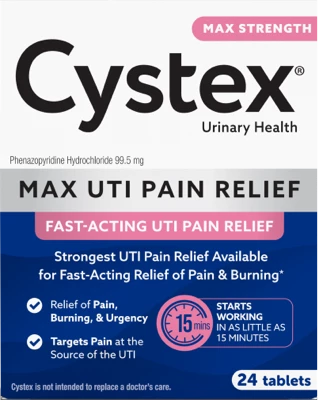-
Products
UTI Relief
Urinary & Vaginal Wellness
Menopausal Health
- UTI Resources
- Helpful Links
- Why Cystex
- Buy Now
Why you need to see a doctor when you get a UTI
By Dr. Allison Hill, OB/GYN
According to the National Institute of Diabetes and Digestive and Kidney Diseases, 60% of women will contract a UTI at some point in their lives and of that 60%, approximately 40% will have another. To put that into perspective, UTIs account for more than 8 million doctor visits each year, making it the second most common type of infection in the body. Needless to say, UTIs are incredibly common, almost like having a cough or a cold. But something that isn’t common is the knowledge of how to treat UTIs properly.
When you get a UTI, you will likely want to treat it as soon as possible because the pain and discomfort can be intense. The good news is that there are options to help ease the pain and stop the infection from getting worse. For example, you can take an over-the-counter product that eases the discomfort and stops the infection from escalating, but the bad news is that you cannot treat or make a UTI go away on your own or with an OTC product; you must see your doctor for antibiotics.
That can be frustrating because you probably want a quick fix, and it may take a few days to get an appointment with your doctor. Or, it may just be downright inconvenient to schedule something during work or school. But treating UTIs properly — with doctor-prescribed antibiotics, that is — is the best thing you can do for your body and emotional wellbeing. UTI symptoms typically go away within a few days of proper treatment with antibiotics, but it is important to take the entire course of medication even if symptoms have improved to be sure to eradicate all of the bacteria in the urinary tract.
When your next UTI comes, here are important things to keep in mind:
- Schedule an appointment with your doctor immediately.
- Take an OTC product like Cystex Pain Relief & UTI Bacteria Control Tablets to ease the pain and discomfort while you wait for that appointment. These particular tablets are unique in that they will not change the color of your urine; other UTI pain relievers cause a fluorescent orange tint that can be alarming to some women.
- Take all of the prescribed antibiotics from your doctor.
- Monitor your symptoms, which should subside within a few days. If they do not, that is an indication that you should consult your doctor again because it may be a more severe infection.
But, you don’t have to wait until you get a UTI to focus on your urinary tract health:
- Focus on maintaining urinary tract health by drinking plenty of water, taking care of your vagina by cleaning it with a baby wipe before and after sex, and wearing breathable undergarments.
- You can also stay UTI-free by implementing a powerhouse supplement into your daily routine (add to a smoothie or a favorite drink). If that’s not your cup of tea, try other options such as high-fiber foods or fermented milk products, all of which have been shown to promote healthy bacteria. These preventive measures will help to keep you UTI-free and out of the doctor’s office.
- Pay attention to recurrent UTIs. UTIs are common but if you are experiencing them constantly, speak with your physician who will investigate further for other causes or contributors. Your doctor may decide to take pictures of your urinary tract with an x-ray or ultrasound, which will show any swelling, stones or blockage.
Not 100 percent sure if you have a UTI? That’s just another reason to schedule an appointment with your physician. Your doctor will test a clean sample of your urine to determine if a UTI is in fact the problem.
No matter if you have had a UTI before or if you’re a UTI novice, it’s crucial to schedule a doctor’s appointment immediately to get diagnosed and treated properly. That is an absolute must.










